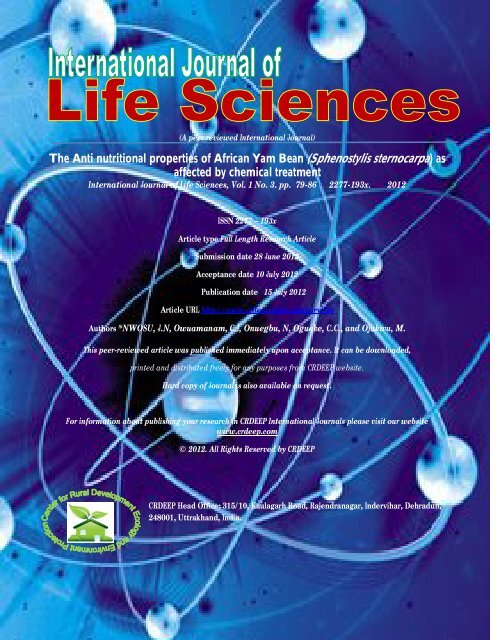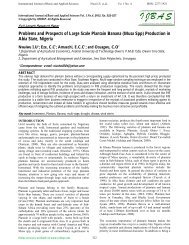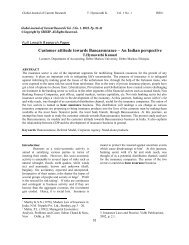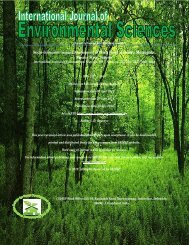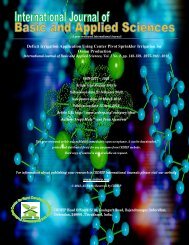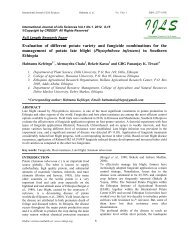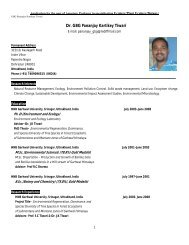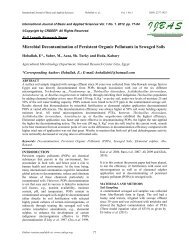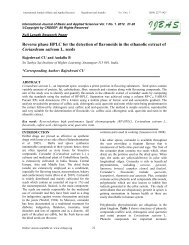The Anti nutritional properties of African Yam Bean ... - CRDEEP
The Anti nutritional properties of African Yam Bean ... - CRDEEP
The Anti nutritional properties of African Yam Bean ... - CRDEEP
- No tags were found...
Create successful ePaper yourself
Turn your PDF publications into a flip-book with our unique Google optimized e-Paper software.
International Journal <strong>of</strong> Life Sciences NWOSU et.al, Vol. 1 No. 3 ISSN: 2277-193Xfood products that require dehulling e.g moi-moi and akara.Other problems associated with <strong>African</strong> yam bean areflatulence and beany <strong>of</strong>f flavor. <strong>The</strong>se have affected theconsumption rate and acceptability <strong>of</strong> <strong>African</strong> yam bean forsubsequent processes.<strong>The</strong> objectives <strong>of</strong> this research work therefore is(i) to investigate the effect <strong>of</strong> soaking <strong>African</strong> <strong>Yam</strong>bean in different chemical (trona/Alum) on theanti<strong>nutritional</strong> <strong>properties</strong> <strong>of</strong> the bean.(ii) to know the effect <strong>of</strong> soaking with these chemicalson the proximate composition <strong>of</strong> these seeds and toselect the best treatment method that can be used toreduce these antinutrients.It is hoped that this will help to expose thefunctionality <strong>of</strong> <strong>African</strong> <strong>Yam</strong> bean and its increasedutilization in food formulations and processing.Materials and MethodsSource <strong>of</strong> Materials:<strong>The</strong> dry seeds <strong>of</strong> <strong>African</strong> yam bean (AYB) (Sphenostylis,sternocarpa) were purchased from a local market in Aba, AbiaState <strong>of</strong> Nigeria.Chemicals<strong>The</strong> Chemicals and equipment used were <strong>of</strong> analytical gradefrom the Department <strong>of</strong> Food Science and Technology andDepartment <strong>of</strong> Crop Science and Technology <strong>of</strong> the FederalUniversity <strong>of</strong> Technology Owerri, Imo State Nigeria.Sample Preparation<strong>The</strong> seeds were first examined and sorted to removeextraneous materials such as dirt, dust, etc as well as shriveledand decreased (pest infected) ones. <strong>The</strong> wholesome ones wereused for the work.<strong>The</strong> wholesome seeds were weighed out in portions, each <strong>of</strong>which was 500g (i.e. 0.5kg). A total <strong>of</strong> twenty (20) portionswere weighed out. <strong>The</strong> weighed portions were further groupedin three sub-groups <strong>of</strong> two (2). <strong>The</strong> groups were labeled, A, B,C which was for control (ie Raw samples) ;Alum treated andTrona treated respectively.<strong>The</strong> Alum treated group was labeled in accordance with thetreatments which were A0.25 a , A0.50 a , A0.75 a , A1.0 a , for24hours soaking and A0.25 b , A0.50 b , A0.75 b , A1.0 b , for48hours soaking. <strong>The</strong> samples in each labeled portion wereeventually soaked separately in Alum solution containing0.25%, 0.50%, 0.75% and 1.0% respectively. <strong>The</strong> ones withsubscripts (a) were allowed to soak for 24hours only whilethose with subscript (b) were soaked for 48hours.Exactly the same treatments that were given to the Alumtreated samples were also given to the Trona treated samples.However, they were soaked in Trona solutions in place <strong>of</strong>Alum solution. Hence they were labeled from T0.25 up toT1.0 a and T0.25 b to T1.0 b .<strong>The</strong> treated samples (soaked in various concentrations <strong>of</strong>Alum and Trona) were allowed to stand at room temperaturefor 24h and 48h according to the treatments. At the end <strong>of</strong>each soaking period, the soaked seeds were brought out,washed in running water (tap) and rinsed in distilled water(this process removes residual treatment salts from the surface<strong>of</strong> the seeds).<strong>The</strong> seeds were then dried in the oven (Carbolite, England) at60 0 C for 8hours and then milled to powder with the aid <strong>of</strong> anelectric laboratory mill (Arther Thomas, USA).After milling,the ground seeds were sieved through 1mm test sieve to obtainprocessed powered sample which was used for the analysis.<strong>The</strong> milling machine was cleaned well after milling eachsample before grinding the next sample. All the groundsamples were put in well labeled screw capped glass amplebottles. Analysis was done on the samples within a period <strong>of</strong>96hours (4days)Determination <strong>of</strong> the <strong>Anti</strong>-Nutritional factorsDetermination <strong>of</strong> Tannin<strong>The</strong> tannin content <strong>of</strong> the sample was determined by FolinDenms Colometric method (Harborne, 1993). A measuredweight <strong>of</strong> the processed sample (5.0g) was mixed withdistilled water in the ratio <strong>of</strong> 1:10 (w/v). <strong>The</strong> mixture wasshaken for 30min at room temperature and filtered to obtainthe extract.A standard tannin acid solution was prepared, 2ml <strong>of</strong> thestandard solution and equal volume <strong>of</strong> distilled water weredispersed into a separate 50ml volumetric flask to serve asstandard and reagent blank respectively. <strong>The</strong>n 2mls <strong>of</strong> each <strong>of</strong>the sample extracts was put in their respective flasks andlabeled.<strong>The</strong> content <strong>of</strong> each flask was mixed with 35ml distilled waterand 1ml <strong>of</strong> the Folin Denms reagent was added to each. Thiswas followed by 2.5mls <strong>of</strong> saturated N a2 CO 3 solution. <strong>The</strong>neach flask was diluted to the 50ml mark with distilled waterand incubated for 90min at room temperature. <strong>The</strong>irabsorbance was measured at 760nm in a colorimeter with thereagent blank at zero. <strong>The</strong> tannin content was calculated asshown below% tannin = 100/w x au/as x c/1000 x vt/vaw = weight <strong>of</strong> sampleau = absorbance <strong>of</strong> test sampleas = absorbance <strong>of</strong> standardtannin solutionc = concentration <strong>of</strong> standardtannin solutionvt = total volume <strong>of</strong> extractva = volume <strong>of</strong> extract analyzedDetermination <strong>of</strong> SaponinThis was done by the double solvent extraction gravimetricmethod (Harborne, 1993). 5.0g <strong>of</strong> the processed sample wasmixed with 50mls <strong>of</strong> 20% aqueous ethanol solution andincubated for 12h at a temperature <strong>of</strong> 55 0 C with constantagitation.After that, the mixture was filtered through what man No 42grades <strong>of</strong> filter paper. <strong>The</strong> residue was re-extracted with 50ml<strong>of</strong> the ethanol solution for 30min and the extracts weighedtogether.Online version is available at: www.crdeep.com80
International Journal <strong>of</strong> Life Sciences NWOSU et.al, Vol. 1 No. 3 ISSN: 2277-193X<strong>The</strong> combined extract was reduced to about 40mls byevaporation and then transferred to a separating funnel andequal volume (40mls) <strong>of</strong> diethyl ether was added to it. Aftermixing well, there was partition and the outer layer wasdiscarded while the aqueous layer was reserved. This aqueouslayer was re-extracted with the ether after which its pH wasreduced to 4.5 with drop wise addition <strong>of</strong> dilute NaOHsolution.Saponin in the extract was taken up in successive extractionwith 60ml and 30ml portion <strong>of</strong> named butanol. <strong>The</strong> combinedextract (ppt) was washed with 5% NaCl solution andevaporated to dryness in a previously weighed evaporationdish. <strong>The</strong> saponin was then dried in the oven (at 60 0 C removesany residual solvent); cooled in a desiccators and re-weighed.<strong>The</strong> saponin content was calculated as shown below;% saponin = W 2 – W 1WW = Weight <strong>of</strong> sample usedW 1 = Weight <strong>of</strong> empty evaporation dishW 2 = Weight <strong>of</strong> dish + Saponin extractDetermination <strong>of</strong> Alkaloids<strong>The</strong> alkaline precipitation gravimetric method (Harbone,1993) was used.A measured weight <strong>of</strong> the processed sample (5g) wasdispersed in 100mls <strong>of</strong> 10% acetic acid in ethanol solution.<strong>The</strong> mixture was well shaken and allowed to stand for 4 hoursat room temperature being shaken every 30min. At the end <strong>of</strong>this period, the mixture was filtered through what man No 42grade <strong>of</strong> filter paper.<strong>The</strong> filtrate (extract) was concentrated by evaporation; to aquarter <strong>of</strong> its original volume. <strong>The</strong> extract was treated withdrop-wise addition <strong>of</strong> concentrated NH 3 solution to precipitatethe alkaloid. <strong>The</strong> dilution was done until the NH 3 was inexcess.<strong>The</strong> alkaloid precipitate was removed by filtration usingweighed what- man No 42 filter paper. After washing with 1%NH 4 OH solution, the precipitate in the filter paper was dried at60 0 C and re-weighed after cooling in a desiccators. <strong>The</strong>Alkaloid content was calculated as shown below:% alkaloid = W 2 – W 1 x 100Wt <strong>of</strong> sample 1Where W 1 = Weight <strong>of</strong> empty filter paperW 2 = Weight <strong>of</strong> filter + Alkaloid pptDetermination <strong>of</strong> PhenolsThis was determined by the Folin – Ciospteanspectrophotometer (AOAC 1990). <strong>The</strong> total phenol wasextracted in 200mg <strong>of</strong> the sample with 10ml concentratedmethanol. <strong>The</strong> mixture was shaken for 30min at roomtemperature.<strong>The</strong> mixture was centrifuged at 500rpm for 15min and thesupernatant (extract) was used for the analysis.1ml portion <strong>of</strong> the extract from each sample was treated withequal volume <strong>of</strong> Folin-Ciosptean reagent followed by theaddition <strong>of</strong> 2mls <strong>of</strong> 2% Na 2 CO 3 solution. Meanwhile, standardphenol solution was prepared and diluted to a desiredconcentration.1ml <strong>of</strong> the standard solution was also treated with the F-Dreagent .Blue colouration was measured (absorbance) in acolour meter at 560nm wavelength. Measurement was with areagent blank at zero.<strong>The</strong> phenol content was calculated using the formulabelow:%phenol = 100 x au x c VtW as 100 VaWhere W = Weight <strong>of</strong> sampleau = absorbance <strong>of</strong> test sampleas = absorbance <strong>of</strong> standard phenol samplec=concentration <strong>of</strong> standard phenol samplevt = total extract volumeva = volume <strong>of</strong> extract analyzedDetermination <strong>of</strong> FlavonoidsFlavonoid was determined using the method described byHarborne (1993).A measured weight <strong>of</strong> the processed sample (5g) was boiled in100mls <strong>of</strong> 2MHCL solution under reflux for 40min. It wasallowed to cool before being filtered. <strong>The</strong> filtrate was treatedwith equal volume <strong>of</strong> ethyl acetate and the mixture wastransferred to a separation funnel. <strong>The</strong> flavonoid extract(contained in the ethyl acetate portion) was received byfiltration using weighed filter paper. <strong>The</strong> weight was obtainedafter drying in the oven and cooling in desiccators. <strong>The</strong> weightwas expressed as a percentage <strong>of</strong> the weight analyzed. It wascalculated as shown below:%Flavonoid = W 2 – W 1 x 100Wt <strong>of</strong> sampleWhere W 1 =Weight <strong>of</strong> filter paper x FlavonoidprecipitateW 2 = Weight <strong>of</strong> filter paper aloneDetermination <strong>of</strong> Hydrogen Cyanide (HCN)This was determined by alkaline pikrate colorimetric methodby Balagopalan et al, (1998) .2g <strong>of</strong> the sample was dispersedin 50ml <strong>of</strong> distilled water in a 25ml conical flask. An alkalinepikrate paper was hung over the sample mixture and the blankin their respective flasks.<strong>The</strong> set up were incubated overnight and each pikrate paperwas eluted or dipped into a 60ml <strong>of</strong> distilled water. A standardcyanide solution was prepared and diluted to a requiredconcentration. <strong>The</strong> absorbance <strong>of</strong> the eluted sample solutionswere measured with colorimeter at 540nm wavelength withthe reagent blank at zero.<strong>The</strong> cyanide content was determined by the formular shownbelow.HCN mg/kg = 100 x au x C x DW asWhere W =weight <strong>of</strong> sample analyzedau = absorbance <strong>of</strong> test sampleas = absorbance <strong>of</strong> standard HCN solutionC = concentration <strong>of</strong> the standard in mg/dD = dilution factor where applicableOnline version is available at: www.crdeep.com81
International Journal <strong>of</strong> Life Sciences NWOSU et.al, Vol. 1 No. 3 ISSN: 2277-193XDetermination <strong>of</strong> PhytatePhytate in the sample was determined using the Biphyrimidinecolorimeter method described by Onwuka (2005). A weighedsample (2g) was soaked in 50ml <strong>of</strong> 0.2N HCl solution andshaker for 30min in a machine shaker. It was filtered to obtainthe extract. A portion <strong>of</strong> the extract (0.5mls) was dispensedinto a test tube and 1ml <strong>of</strong> acidified ferrous ammonia sulphitesolution was added to it. <strong>The</strong> tube was stoppered and boiled inwater bath for 30min. It was then cooled in ice water for15min and allowed to reach room temperature. <strong>The</strong> mixturewas centrifuged at 3000 rpm for 5min and the supernatant wascollected for analysis. 1ml <strong>of</strong> the supernatant was mixed with1.5ml <strong>of</strong> 2.2 Biphrimidine solutions. Meanwhile a standardsolution <strong>of</strong> phytate was prepared and diluted to a chosenconcentration. 1ml <strong>of</strong> the standard solution was treated thesame way as the sample extract as described above. <strong>The</strong>absorbance <strong>of</strong> the standard and the sample were read in aspectrophotometer at a wavelength <strong>of</strong> 519nm.A reagent blank was used to set the instrument at zero. <strong>The</strong>formular below was used to calculate the phytate content.%phytate = 100 x au x c x VtW as 100 VaWhere au = Absorbance <strong>of</strong> sampleas = Absorbance <strong>of</strong> standard solutionc = Concentration <strong>of</strong> the standardVt = Total volume <strong>of</strong> extractVa = Volume <strong>of</strong> extract analyzed.Determination <strong>of</strong> Oxalate5g <strong>of</strong> the sample was weighed into a 100ml beaker, 20ml <strong>of</strong>0.30N HCl was added and warmed from 40 – 50 0 C, usingmagnetic hot plate and stirred for one hour. It was extractedthree times with 20ml <strong>of</strong> 0.30N HCl and filtered into a 100mlvolumetric flask. <strong>The</strong> combined extract was diluted to 100mlmark <strong>of</strong> the volumetric flask.<strong>The</strong> oxalate was estimated by pipetting 5ml <strong>of</strong> the extract intoa conical flask and made alkaline with 1.0ml <strong>of</strong> 5Nammonium hydroxide. A little indicator paper was placed inthe conical flask to enable us know the alkaline regions. It wasalso made acid to Phenolphalein (2 or 3 drops <strong>of</strong> this indicatoradded, excess acid decolourizes solution) by dropwiseaddition <strong>of</strong> glacial acetic acid. 1.0ml <strong>of</strong> 5% C a CI 2 was thenadded and the mixture allowed to stand for 3h after which itwas then centrifuged at 3000rpm for 15min. <strong>The</strong> supernatantswere discarded and the precipitates washed 3 times with hotwater with thorough mixing and centrifuging each time. Twomilliliters <strong>of</strong> 3N H 2 SO4 was added to each tube and theprecipitates dissolved by warming in a water bath (70 – 80 0 C).<strong>The</strong> content <strong>of</strong> all the tubes was carefully poured into a cleanconical flask and titrated with freshly prepared 0.05M KMnO 4at room temperature until the first pink colour appeared till thesolution became colourless. <strong>The</strong> solution was then warmed to70 – 80 0 C and titrated until a permanent pink colour thatpersisted for at least 30 seconds was attained.Determination <strong>of</strong> Trypsin InhibitorThis was done using the spectrophotometric method,described by Amtfield et al; (1985).A measured weight (2g) <strong>of</strong> the test sample was dispersed in50ml <strong>of</strong> 0.5M NaCl solution and stirred for 30min at roomtemperature. It was centrifuged and the supernatant filteredthrough Whatman No 42 filter paper. <strong>The</strong> filtrate was used forthe assay.Standard trypsin was prepared and used to treat the substratesolution (N-benzoyl – D1 – arginine – p – anilide; BAPA).<strong>The</strong> extent <strong>of</strong> inhibition was used as a standard for measuringthe trypsin inhibitory activity <strong>of</strong> the test sample extract. Into atest tube containing 2ml <strong>of</strong> extract and 10ml <strong>of</strong> the substrate(BAPA) 3ml <strong>of</strong> the standard trypsin solution was added. Also2ml <strong>of</strong> the standard trypsin solution was added in another testtube containing only 10ml <strong>of</strong> the substrate. <strong>The</strong> latter served asthe blank/control.<strong>The</strong> content <strong>of</strong> the tubes were allowed to stand for 30min andthen the absorbances <strong>of</strong> the solution measuredspectrophotometrically at 410nm wavelength.One trypsin activity unit inhibited is given by an increase <strong>of</strong>0.01 absorbance unit at 410nm.Trypsin unit inhibited= Au x 0.01 x F x Vt x 1As Va wWhere Au = Absorbance <strong>of</strong> test sampleAs = Absorbance <strong>of</strong> standard (uninhibited)sampleF = Experimental factors given asVt = Total volume <strong>of</strong> extractVa = Volume <strong>of</strong> extract analyzedW = Weight <strong>of</strong> sample analyzed.Results and DiscussionEffects <strong>of</strong> chemical (alum) treatment, soaking time andconcentration on the anti<strong>nutritional</strong> <strong>properties</strong> <strong>of</strong> africanyam bean.Table 1 shows the anti<strong>nutritional</strong> factors <strong>of</strong> <strong>African</strong> yam bean(AYB) soaked with different concentrations <strong>of</strong> alum. For 24halkaloid showed no significant difference (P≥0.05) withdifferent concentrations <strong>of</strong> alum. Hydrogen cyanide (HCN)was highest in the untreated AYB (9.89mg/kg) and lowest inthat <strong>of</strong> 1.00% (7.51mg/kg). <strong>The</strong>re was a significant difference(P≤0.05) in the HCN contents <strong>of</strong> the AYB samples soakedwith different concentrations <strong>of</strong> alum for 24h. Tannin <strong>of</strong>untreated AYB was highest (0.41%) while AYB soaked with1% concentration <strong>of</strong> alum was lowest (0.194%). <strong>The</strong>re was nosignificant difference in the tannin contents <strong>of</strong> AYB ( 0.5, 0.75and 1.0% concentrations <strong>of</strong> alum. Saponin was highest in theuntreated AYB (0.5%) and lowest in AYB soaked with 1.0%concentration <strong>of</strong> alum (0.33%).<strong>The</strong>re was a significantdifference (P ≤ 0.5) in the saponin contents <strong>of</strong> the AYBsamples. Flavanoid showed no significant difference (P ≥ 0.5)in the untreated AYB and AYB soaked with differentconcentrations <strong>of</strong> alum. Flavanoids ranged from 0.40 – 0.41%.Total titratable acidity (TTA) was highest in the untreatedAYB (2.5%) and lowest in that <strong>of</strong> 1.0% (1.3%). However,there was no significant difference (P ≥ 0.05) in TTA <strong>of</strong> thetreated and untreated AYB samples. Phytate was highest in theuntreated AYB and AYB soaked with 0.25% concentration <strong>of</strong>alum (0.32%) and lowest in 1.0% concentration <strong>of</strong> alum(0.30%). <strong>The</strong>re was no significant difference (P ≥0.05) in thephytate content <strong>of</strong> the untreated AYB and that soaked withdiffused concentration <strong>of</strong> alum . Oxalate was highest in theOnline version is available at: www.crdeep.com82
International Journal <strong>of</strong> Life Sciences NWOSU et.al, Vol. 1 No. 3 ISSN: 2277-193Xuntreated AYB (0,36%) and lowest in AYB soaked with0.75% and 1.0% concentrations <strong>of</strong> alum with a value <strong>of</strong> 0.25<strong>The</strong>re was no significant difference (P≥ 0.05) in the oxalatecontent <strong>of</strong> AYB soaked with 0.75% and 1.0% concentrations<strong>of</strong> alum. Phenol was highest in AYB soaked with 1.0% <strong>of</strong>concentration <strong>of</strong> alum and lowest in other concentrations andthe untreated AYB. <strong>The</strong>re was no significant difference(P≥0.05) in the phenols <strong>of</strong> the treated AYB andthe untreated AYB. From this result, it could be inferred thatthe soaking <strong>of</strong> AYB with alum helped to reduce theiranti<strong>nutritional</strong> <strong>properties</strong>, but for the concentration <strong>of</strong> phenols.Table 1: Mean values <strong>of</strong> the anti<strong>nutritional</strong> <strong>properties</strong> <strong>of</strong> <strong>African</strong> yam bean soaked for 24h and 48h with differentconcentrations <strong>of</strong> alumTRT(24H)Control0.250.500.751.00LSD(0.05%)48HControl0.500.751.00LSD(0.05%)ALK%0.37 a0.37 a0.37 a0.34 a0.34 a0.030.37 a0.35 b0.33 c0.31 d0.02HCNmg/kg9.89 a9.80 a7.73 c7.61 d7.51 e0.029.89 a7.07 c7.01 d6.95 e0.02TANNIN%0.41 a0.28 b0.20 c0.20 c0.19 c0.020.41 a0.187 c0.183 d0.180 e0.001SAPONIN%0.57 a0.50 b0.43 c0.39 d0.33 e0.030.57 a0.41 b0.39 b0.31 b0.10FLAV%0.41 a0.41 a0.40 a0.41 a0.41 a0.020.41 a0.41 a0.41 a0.41 a0.01TTA%2.5 a1.5 a2.0 a1.8 a1.3 a0.022.5 a2.0 c1.8 d1.7 c0.08PHYTATE%0.322 a0.320 a0.313 a0.312 a0.307 a0.020.322 a0.315 b0.312 c0.306 d0.02OXALATE%0.36 a0.33 b0.27 c0.25 d0.25 d0.020.36 a0.25 c0.24 cd0.23 d0.02PHENOL%0.16 a0.16 b0.16 b0.16 b0.50 a0.02Mean values down the columns with the same letters are not significantly different at (p ≥ 0.05). Key: control = untreated AYB 0.25, 0.50, 0.75 and 1.0% =different concs alum, ALK = alkaloid, HCN = Hydrogen Cynide, TTA = total titratable acidity, LSD = least significant difference.0.16 a0.16 a0.16 a0.50 a0.02<strong>The</strong> effect <strong>of</strong> alum treatment on the anti<strong>nutritional</strong><strong>properties</strong> <strong>of</strong> ayb for 48h<strong>The</strong> anti<strong>nutritional</strong> <strong>properties</strong> <strong>of</strong> AYB soaked with differentconcentration <strong>of</strong> alum for 48h is also shown in Table 1.Alkaloid was highest in the untreated AYB (0.37%) andlowest in that <strong>of</strong> AYB soaked with 1.0% concentration <strong>of</strong>alum (0.31%). <strong>The</strong>re was no significant difference (P ≥0.05)in the AYB samples soaked with 0.5% and 0.25%concentrations <strong>of</strong> alum. HCN was highest the untreated AYB(9.89mg/kg) and lowest in AYB soaked with 1.0%concentration <strong>of</strong> alum (6.95mg/kg). <strong>The</strong>re was a significantdifference (P≤ 0.05) in the HCN <strong>of</strong> the AYB samples.Tanninwas highest in the untreated AYB (0.41%) and lowest in theAYB soaked with 1.0% concentration <strong>of</strong> alum (0.180%).<strong>The</strong>re was a significant difference (P≤0.05) in tannin contents<strong>of</strong> the untreated and treated AYB samples. Saponin washighest in the untreated AYB (0.57%) and lowest in AYBsoaked with 1.0% concentration <strong>of</strong> alum (0.31%). <strong>The</strong>re wasno significant difference (P≥0.05) in the saponin <strong>of</strong> theuntreated AYB and AYB soaked with 0.25% concentration <strong>of</strong>alum. Also, there was no significant difference (P≥0.05) in thesaponins <strong>of</strong> AYB soaked with 0.75%, 0.5% and 1.0%concentration <strong>of</strong> alum. <strong>The</strong>re was no significant difference(P≥0.05) in the flavanoids <strong>of</strong> the untreated and treated AYBsamples. TTA s was highest in the untreated AYB (2.3%) andlowest in AYB soaked with 1.0% concentration <strong>of</strong> alum(1.70%). <strong>The</strong>re was a significant difference (P≤0.05) in thetotal titratable acidity <strong>of</strong> the untreated and treated AYBsamples. Phytate was highest in untreated AYB (0.322%) andlowest in AYB soaked with 1.0% concentration <strong>of</strong> alum(0.306%). <strong>The</strong>re was no significant difference (P≥0.05) in theAYB soaked with 0.25% and 0.5% concentration <strong>of</strong> alum.Oxalate was highest in the untreated AYB (0.360%) andlowest in that <strong>of</strong> AYB soaked with 1.0% concentration <strong>of</strong>alum (0.23%). Phenol showed no significant difference(P≥0.05) in the untreated and treated AYB samples.Effect <strong>of</strong> soaking with trona on the anti<strong>nutritional</strong><strong>properties</strong> <strong>of</strong> ayb soaked for 24h.<strong>The</strong> anti<strong>nutritional</strong> <strong>properties</strong> <strong>of</strong> <strong>African</strong> yam bean (AYB)soaked for 24h with different concentrations <strong>of</strong> trona is shownin table 2. <strong>The</strong> Alkaloid content was highest in untreated AYB(0.37%) and lowest in AYB soaked with 1.0% concentration<strong>of</strong> trona (0.31%). <strong>The</strong>re was no significant difference (P≥0.05)in the alkaloids <strong>of</strong> AYB soaked with different concentration <strong>of</strong>trona but they differed with the untreated (control) sample.Hydrogen cyanide (HCN) was highest in the untreated AYB(9.89%) and lowest in AYB soaked with 1.0% concentration<strong>of</strong> trona (3.15%). <strong>The</strong>re was a significant difference (P≤0.05)in the HCN contents <strong>of</strong> untreated AYB and differentconcentration <strong>of</strong> trona and between each concentration level.Tannin was highest in the untreated AYB (0.197%) and lowestin AYB soaked with 1.0% concentration <strong>of</strong> trona (0.185%).<strong>The</strong>re was no significant difference (P≥0.05) in the tannins <strong>of</strong>AYB soaked with 0.5% and 0.75 concentration <strong>of</strong> tronathough there were significant difference between them.Saponin was highest in AYB soaked with 0.75% and 1.00Online version is available at: www.crdeep.com83
International Journal <strong>of</strong> Life Sciences NWOSU et.al, Vol. 1 No. 3 ISSN: 2277-193Xconcentration <strong>of</strong> trona (0.63%) and lowest in the untreatedAYB (0.56%). <strong>The</strong>re was no significant difference (P≥0.05) inthe saponin contents <strong>of</strong> AYB treated with differentconcentrations <strong>of</strong> trona. This result indicates that increase inthe trona concentration increased the saponin content andtherefore is not recommended for use in food formulations.Flavanoid was highest in untreated AYB (0.41%) and lowestin AYB soaked in 1% concentration <strong>of</strong> Trona (0.37%). <strong>The</strong>rewas no significant difference that teated with 0.25% Trona.<strong>The</strong>re was no significant difference (P≥0.05) in the flavonoidcontents <strong>of</strong> AYB soaked with 0.25%, 0.75% and 1%concentration <strong>of</strong> Trona.Total titratable auldity (TTA) washighest in untreated AYB (2.50%) and lowest in AYB treatedwith 1.0% concentration <strong>of</strong> trona 1.70. <strong>The</strong>re was nosignificant difference (P≥0.05) in the TTA <strong>of</strong> AYB soakedwith 0.5%, 0.75% and 1.0% concentrations <strong>of</strong> trona. Phytatewas highest in the untreated AYB (0.322%) and lowest inAYB soaked with 1.0% concentration <strong>of</strong> trona (0.193%).<strong>The</strong>re was a significant difference (P≤0.05) in the untreatedAYB and AYB soaked with different concentrations <strong>of</strong> trona.Oxalate was highest in the untreated AYB 0.36% and lowestin AYB soaked with 1.0% concentration <strong>of</strong> trona (0.290%).Phenol was highest in the untreated AYB (0.16%) and lowestin AYB soaked with 1.0% concentration <strong>of</strong> trona (0.09%).<strong>The</strong>re was no significant difference (P≥0.05) in phenol at0.75% and 1.0% concentration <strong>of</strong> trona. Alkaloids <strong>of</strong> thesoaked AYB reduced with increase in the concentrations <strong>of</strong>alum and trona for 24h and 48h. Hydrogen cyanide in thesoaked AYB also showed reduction with increase in theconcentrations <strong>of</strong> alum and trona for 24h and 48h.Soaking <strong>of</strong> AYB with different concentration <strong>of</strong> alum andtrona for 24h and 48h gave significant reduction. However,some trace element <strong>of</strong> tannins recorded in the study could be<strong>of</strong> health advantage. Recent studies have demonstrated thatproducts containing chestnut tannins included at low dosages(0.15-0.2%) in the diet can be beneficial (Ologhobo et al,1993). Some studies suggest that chestnut tannins have beenshown toTable 2: Mean values <strong>of</strong> the anti<strong>nutritional</strong> <strong>properties</strong> <strong>of</strong> <strong>African</strong> yam bean soaked for 24h and 48h with differentconcentration <strong>of</strong> tronaTRT ALK HCN TANNIN SAPONIN FLAV TTA PHYTATE OXALATE PHENOL(24h) % mg/kg % % % % % % %Control 0.37 a 9.89 a 0.197 a 0.57 b 0.41 a 2.50 a 0.322 a 0.36 a 0.16 a0.25 0.33 b 6.54 b 0.191 b 0.61 a 0.40 ab 2.20 b 0.307b 0.33 b 0.13 b0.50 0.33 b 5.40 c 0.187 c 0.61 a 0.39 bc 1.80 c 0.281 c 0.32 bc 0.13 b0.75 0.31 b 3.85 d 0.187c 0.63a 0.38 cd 1.80 c 0.253 0.31 c 0.10 c1.0 0.31 b 3.15 c 0.185 c 0.63 a 0.37 d 1.70 d 0.193 c 0.29 d 0.09 cLSD 0.02 0.02 0.002 0.03 0.02 0.14 0.003 0.02 0.02(0.05%)48HControl 0.37 a 9.89 a 0.197 a 0.57 b 0.41 a 2.50 a 0.322 a 0.36 a 0.16 a0.25 0.30 b 4.00 b 0.189 b 0.63 b 0.35 b 1.80 b 0.285 b 0.288 b 0.12 b0.50 0.29 bc 3.06 c 0.186 c 0.65 b 0.33 bc 1.70 b 0.272 c 0.280 b 0.08 c0.75 0.29 bc 3.03 c 0.182 d 0.71 a 0.331 c 1.20 c 0.222 d 0.26 b 0.07 c1.0 0.27 c 0.51 c 0.179 c 0.73 a 0.31 c 1.20 c 0.187 c 0.27 b 0.07 cLSD 0.02 0.81 0.003 0.05 0.03 0.26 0.002 0.02 0.01Mean values down the columns with the same letters are not significantly different at (p≥0.05). Key: control = untreated AYB; 0.25, 0.50, 0.75 and 1.0% =different concs <strong>of</strong> alum, ALK = alkaloid, HCN = Hydrogen cynide, TTA = total titratable acidity, LSD = least significant difference.have positive effects on silage quality in the rand bale silages,in particular reducing non protein nitrogen (NPNs) in thelowest wilting level (Tobacco et al, 2006). Also improvedferment ability <strong>of</strong> soya meal nitrogen in the rumen has alsobeen reported by Mathew and Jouany (1993).Effects <strong>of</strong> trona treatment on the anti-<strong>nutritional</strong><strong>properties</strong> <strong>of</strong> ayb soaked for 48h.<strong>The</strong> anti-<strong>nutritional</strong> <strong>properties</strong> <strong>of</strong> AYB soaked for 48h withdiffuse concentration <strong>of</strong> trona is shown in Table 2. Alkaloidwas highest in the untreated AYB (0.37%) and lowest in AYBsoaked with 1.0% concentration <strong>of</strong> trona (0.27%). <strong>The</strong>re wasno significant different (P≥0.05) in the alkaloids <strong>of</strong> AYBsoaked with 0.25% 0.50% and 0.75% concentration <strong>of</strong> trona.Also, there was no significant difference (P≥0.05) in that <strong>of</strong>0.75% and 1.0% concentration <strong>of</strong> trona. HCN was highest inuntreated AYB (9.89%) and lowest in AYB soaked with1.00% concentration <strong>of</strong> trona (0.51). <strong>The</strong>re was no significantdifference (P≥0.05) in the HCN <strong>of</strong> AYB soaked with 0.5%,0.75% and 1.0% concentration <strong>of</strong> trona. Tannin was highest inthe untreated AYB (0.197%) and lowest in AYB soaked with1.0% concentration <strong>of</strong> trona (0.179%). <strong>The</strong>re was a significantdifference (P≤0.05) in the tannin contents <strong>of</strong> AYB soaked withdifference concentration <strong>of</strong> trona and untreated AYB. Saponinwas highest in AYB (0.57%). <strong>The</strong>re was no significantdifference (P≥0.05) in the saponin <strong>of</strong> AYB soaked with 1.0%and 0.75% concentrations <strong>of</strong> trona though it was in anincreasing trend. Flavanoid was highest in the untreated AYB(0.41%) and lowest in AYB soaked with 1.0% and 0.75%concentration <strong>of</strong> trona (0.31%). <strong>The</strong>re was no significantdifference (P≥0.05) in the flavanoid contents <strong>of</strong> AYB soakedwith 0.5%, 0.75% and 1.0% concentrations <strong>of</strong> trona. TTA washighest in the untreated AYB (2.50%) and lowest AYB soakedwith 0.75% and 1.0% concentration <strong>of</strong> trona (1.2%). <strong>The</strong>rewas no significant different (P≥0.05) in the TTA <strong>of</strong> AYBsoaked with 0.25% and 0.5% concentrations <strong>of</strong> trona; 0.75%Online version is available at: www.crdeep.com84
International Journal <strong>of</strong> Life Sciences NWOSU et.al, Vol. 1 No. 3 ISSN: 2277-193Xand 1.0% concentrations <strong>of</strong> trona. Phytate was highest in theuntreated AYB (0.322%) and lowest in 1.0% concentration <strong>of</strong>trona (0.187%). <strong>The</strong>re was a significant difference (P≤0.05) inthe phytate contents <strong>of</strong> untreated AYB and AYB soaked withdifferent concentration <strong>of</strong> trona. Oxalate was highest in theuntreated AYB (0.36%) and lowest in AYB soaked with0.75%) concentrations <strong>of</strong> trona (0.26%).<strong>The</strong>re was no significant difference (P≥0.05) in the oxalatecontents <strong>of</strong> AYB treated with different concentrations <strong>of</strong> trona.Phenol was highest in untreated AYB (0.16%) and lowest inAYB soaked with 0.75% and 1.0% concentrations <strong>of</strong> trona(0.07%). <strong>The</strong>re was no significant difference (P≥0.05) in thephenols <strong>of</strong> AYB soaked with 0.50%, 0.75% and 1.0%concentrations <strong>of</strong> trona.Saponins present in the AYB reduced to mineral levels whensoaked with different concentrations <strong>of</strong> alum and trona for 24hand 48h. <strong>The</strong> result confirms with the report <strong>of</strong> Onimawo andAkubor. (2005), that alkaline washing or dry scouring andabrasive dehulling have been suggested as techniques forsaponins reductions in legumes. Saponins are not destroyedduring cooking. However trace elements <strong>of</strong> saponins are<strong>nutritional</strong>ly beneficial because <strong>of</strong> their hypocholestorolemicactivity (cholesterol lowering) (Pnimawo and Akubor, 2005).Reduction in phytate, typsin inhibitors and tannins in thesoaked AYB with different concentrations <strong>of</strong> alum and tronafor 24h and 48h are in agreement with the report <strong>of</strong> Mubarak(2005) on the <strong>nutritional</strong> compensation and anti-<strong>nutritional</strong>factors <strong>of</strong> mung bean seeds (phaseolus aurew) as affected bysome home traditional processes. Reduction <strong>of</strong> phytate usingdifferent chemicals and soaking time also confirms with thework <strong>of</strong> Wikipedia, (2005) report that home food preparationtechniques can reduce phytic acid by simply cooking to somedegree. More effective methods are soaking on and acidmedium, lactic acid fermentation and spronting. Reduction intypsin inhibitor to minimal levels in the soaked AYB withalum and trona for 24h and 48h is in line with the previouswork reported by Eicher and Satterlee (1988) that a substantialamount <strong>of</strong> typsin inhibitors have been reported to leach out <strong>of</strong>great Northern beans by soaking in acidic or alkalinesolutions.Fernandez et al., (1993) observed that soaking fava beans in0.7% sodium bicarbonate solution was more effective indecreasing typsin inhibitor activity than soaking in 0.1% citricacid solution probably due to the stability <strong>of</strong> inhibitor in acidicP H.Soaking <strong>of</strong> AYB with different concentrations <strong>of</strong> alum ortrona for 24h and 48h gave oxalate values below the lowestpublished lethal dose <strong>of</strong> 600mg/kg in humans (SOPC, 2005).ConclusionIt could therefore be concluded, based on the findings fromthis research work, that the use <strong>of</strong> alum and trona reduced theantinutrient <strong>properties</strong> <strong>of</strong> AYB seeds. Most antinutrients likealkaloid, saponin, HCN, tannin, phytate and oxalatesignificantly reduced by soaking in alum for 24h and 48hrespectively. However phenols and Flavanoid were notaffected by soaking in alum. Soaking in trona however causedreduction in flavanoid and phenol <strong>of</strong> which were stable toalum effect. It was also observed that on the whole, trona hadmore effect on the anti<strong>nutritional</strong> <strong>properties</strong> than alum and thiswas attributed to the s<strong>of</strong>tening effect <strong>of</strong> trona on the cotyledonwhich probably had an increased solubility and leaching <strong>of</strong> theantinutrient into the soak water.ReferencesAmtfield, S.D; Ismond, M.A.H and Murray, E.D. (1985).<strong>The</strong> fate <strong>of</strong> anti<strong>nutritional</strong> factors during the preparation <strong>of</strong>fava bean protein Isolate using a miccllization technique.Canadian Institute <strong>of</strong> Fd. Sc. Tech. J. 18 (2): Pg 137-143.A.O.A.C. (1990) Official method <strong>of</strong> analysis (11 th edn).Association <strong>of</strong> <strong>of</strong>ficialAgricultureChemists, Washington. SC, USA.Balagopalan, C; Padmaja, G; Nanda, S.K and moorthy,S.W. (1988). Cassava in food, feed and industry. CRC PressInc. Florida Pg 187-189Bliss, F.A. (1995). Cowpea in Nigeria. In proceeding <strong>of</strong> asymposition on Nutritional improvement <strong>of</strong> legumes bybreeding 3-5 July 1995 New York, Nations, proteins Advisorygroup Pg 71-82.Eggum, B.O. (1984). Factors affecting the protein quality<strong>of</strong> pigeon pea (Cajanus Cajan) as influenced by seedpolyphenols. Plant foods for human nutrition. 43:171-179.Eicher, N.J and Satterlee, L.D (1988). Nutritionalquality <strong>of</strong> Great Northern bean proteins processed at baryingpH. J. Food Sci, 53: 1139-1143Enwere, N.J. (1986). Effect <strong>of</strong> temperature and dryingon selected legumes. Msc. <strong>The</strong>sis Department <strong>of</strong> Food Scienceand Technology. University <strong>of</strong> Nigeria, Nsukka. 21:337-294.Fernandez, N.M. Aranda, P, Lopez Mrado, M. Urbano,G. Estrella, I. Sotonmayor, C; Diaz, C; Prodanor, M; Frisc, J.and Bidal-Balverde, C. (1993). Effect <strong>of</strong> processing on somenutritive factors <strong>of</strong> fava beans: Influence on proteindigestibility and food intake in rats. In: Recent advances <strong>of</strong>research in anti<strong>nutritional</strong> factors in Legume seeds;Wageningen Per: Wageninge, <strong>The</strong> Nether lands, Pg 467-471Gbadge, P, N, Vairagar, P.R and Prasad, K (2008),Physical <strong>properties</strong> <strong>of</strong> click pee split (CicerarietiumL)Agricultural Engineering International: <strong>The</strong> CIGR Ejournal,Manuscript FP 07 039. Vol. x.Gonzadez, S., pebon, ML, and Carulla, J (2002). Effects<strong>of</strong> tannins on the invitro ammonia release and dry matterdegradation <strong>of</strong> soybean meal. Arch. Latinoam. Prod. Anim. 10(2): 97-101.Harborne J.B. (1993) Photochemical methods Chapmanand Hall, New YorkHenshaw F.O. and Sanni S.A. (1995): <strong>The</strong> effects <strong>of</strong> seedphysical <strong>properties</strong> and chemical composition on the cooking<strong>properties</strong> <strong>of</strong> seven cowpea (vigna unguiculataa) varieties.Nigeria fd. 13:53-63Hussein M.A, Akinyele I.O. Omololu A, andAkinlosotu A. (1984). Medical problems associated withconsumption <strong>of</strong> cowpea, perception <strong>of</strong> Nigeria woman paperpresented at the world cowpea Research conference, IITA,Ibadan November 4-9Kumar, S. Singh, G.K. Kumar, R, Bhatia, N.K andAwasthi. C.P. (1984). Variation in quality traits <strong>of</strong> Pigeon pea(Cajanus Cajan L. Mill SP.) varieties. Journal <strong>of</strong> food scienceand Technology. 28:173-174Online version is available at: www.crdeep.com85
International Journal <strong>of</strong> Life Sciences NWOSU et.al, Vol. 1 No. 3 ISSN: 2277-193XLu, A.K. and Jorqunun, C. (1982). Education <strong>of</strong> qualitylegumes in Asia-journal <strong>of</strong> food science.Mathew, F and Jouany, J.P (1993). ‘Effect <strong>of</strong> chestnuttannin on the ferment ability <strong>of</strong> soybean meal nitrogen in therumen ‘Ann Zootech. 42:127Mubarak, A.E (2005). Nutritional composition andanti<strong>nutritional</strong> factors <strong>of</strong> mung bean seeds (phaseolus auureus)as affected by some home traditional processes J. foodchemistry 89: Pp 489-495Ngoddy, P.O, Enwere, N.J. and Onuora, V.I. (1986).Cowpea flour performance in akara and moi.moi preparations.Tropical Science 21:337-294Ologhobo A.D., Apata, D.F. and Oyejide, A.(1993).Utilization <strong>of</strong> raw jack bean (Canavalia ensiformis) and jackbean fractions in diets for broiler chicks. Br.Poult. Sci.,34:323-337.Onwuka, G.I (2005). Corporative studies on the winningpotentials <strong>of</strong> black tamarind, local grape fruit and exotic apple.Department <strong>of</strong> Food Science and Technology, Michael OkparaUniversity <strong>of</strong> Agriculture. Journal <strong>of</strong> Food Technology 4(4):350-353.Osagie, A.U. (1998). Post harvest research unit.Department <strong>of</strong> Biochemistry, University <strong>of</strong> Benin Pg 221-244Prakash, D. and Misra, P.S. (1987), Protein and Aminoacid composition <strong>of</strong> some leguminous seed. Plant food forhuman Nutrition. 37:29-32SOPC(2005) Safety Officer in Physical Chemistry.Safety (MSDS) data for oxalic acid dehydrate. OxfordUniversity.SAS (2000) SAS Users Guide. (Version 8). Cary, NC:SAS Institute Inc.Somari, R.O. and Balogh, E. (1993). Effect <strong>of</strong> soakingon the oligosaccharide conent <strong>of</strong> cowpea flour Journal <strong>of</strong>science food Agriculture. 61:339-343Tobacco. E., Borreshi, Crobetto, G.M, Galassi, G.,Colonbo, D and Cavallarin, L (2006). Effect <strong>of</strong> chestnut tanninon fermentation quality, proteolysis, and protein rumendegradability <strong>of</strong> alfalfa silage. J. Diary Sci. 89(12): 473-46.Wikipedia C. Yard (2005) long bean In ;Freeencyclopedia; http://www.buytikitorches.com Accessed,2005Feb.,2007.Online version is available at: www.crdeep.com86


